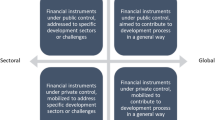Abstract
The advent of the new millennium has witnessed the embracing of a different perspective on global health aid. New and innovative mechanisms in health-aid financing are leading to new opportunities, focused on greater innovation, risk taking and speed. However, these opportunities might not fully materialize if the traditional approaches of channeling and using funds are followed. To maximize global aid effectiveness and to have a realistic chance of achieving the Millennium Development Goals, the implementation of a holistic approach to the global architecture of health aid will be essential.
This is a preview of subscription content, access via your institution
Access options
Subscribe to this journal
Receive 12 print issues and online access
$209.00 per year
only $17.42 per issue
Buy this article
- Purchase on Springer Link
- Instant access to full article PDF
Prices may be subject to local taxes which are calculated during checkout


Similar content being viewed by others
References
Bloom, D. E & Canning, D. The health and wealth of nations. Science 287, 1207–1209 (2000).
Anon. The World Health Report (WHO, Geneva, 1999).
Brundtland, G. H. in Respect for the Earth: the 2000 Reith Lectures 56–57 (Profile Books, London, 2000).
Anon. Macroneconomics & Health: Investing in Health for Economic Development. Report of the Commission on Macroeconomics and Health (WHO, Geneva, 2001).
Coordinating Committee of the Global HIV/AIDS Vaccine Enterprise. The global HIV/AIDS Vaccine Enterprise: Scientific Strategic Plan. PLoS Med. 2, e25 (2005).
Anon. The World Health Report <http://www.who.int/whr/2005/en/> (WHO, Geneva, 2005).
Anon. Global Development Finance 2005 (online) (World Bank, Washington DC, 2005).
Sanders, D. et al. Public Health in Africa. in Global Public Health: A New Era (ed. Beaglehole, R.) 135–155 (Oxford University Press, Oxford, 2003).
Acknowledgements
The author would like to acknowledge fruitful discussions with R. Klausner (Bill & Melinda Gates Foundation) and R. Manning (OECD/DAC). Andy Crump and Renia Coghlan helped in the preparation of the manuscript.
Author information
Authors and Affiliations
Corresponding author
Ethics declarations
Competing interests
The author declares no competing financial interests.
Supplementary information
Related links
Related links
FURTHER INFORMATION
Development Assistance Committee
Global Alliance for Vaccines and Immunization
Global Fund to Fight AIDS, TB and Malaria
The Global HIV/AIDS Vaccine Enterprise
Macroeconomic and Health Commission
Organization for Economic Cooperation and Development
Rights and permissions
About this article
Cite this article
Godal, T. Do we have the architecture for health aid right? Increasing global aid effectiveness. Nat Rev Microbiol 3, 899–903 (2005). https://doi.org/10.1038/nrmicro1269
Published:
Issue Date:
DOI: https://doi.org/10.1038/nrmicro1269



